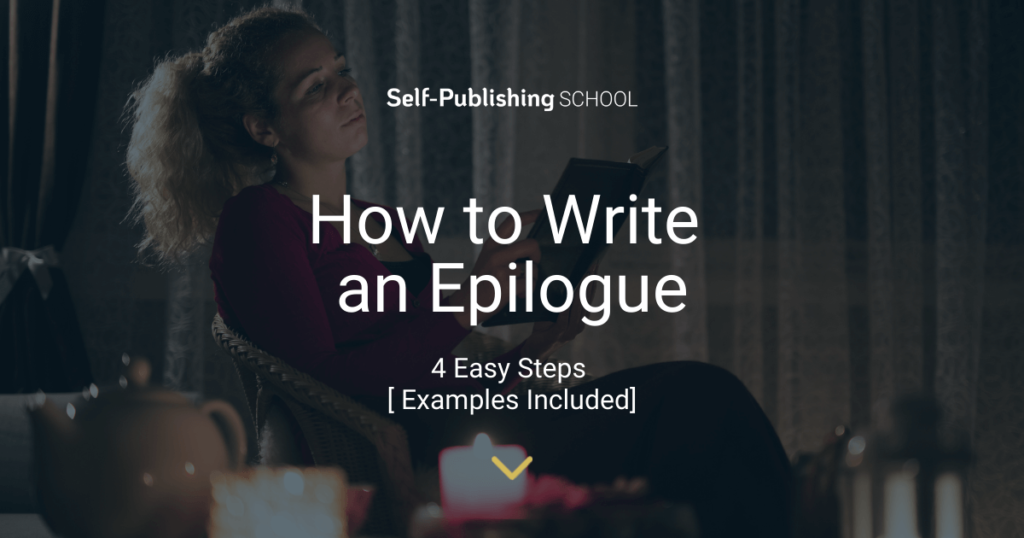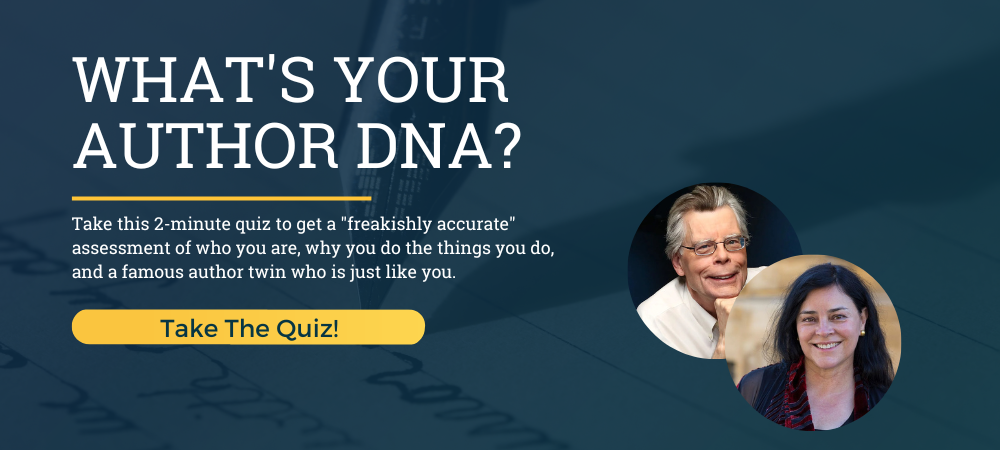When constructing a finalized novel, there’s much more to the book than just the story itself.
Books have many parts, and each serves a special purpose.
While you might not include all of the possible sections in your final product, understanding each and knowing why and how they’re used will help you create a full, professional-looking book.
Today, we’re talking how to write an epilogue.
What is an epilogue?
An epilogue, in fiction, is a supplemental part of a story. It appears after the story, and is often used to wrap up loose ends, or to see where the characters have ended up. It is typically set in the future from the main story.
Sometimes an epilogue can be used to set up or drop hints for the next installment in a series.
Epilogues are not a necessary part of a book, though many books include them.
Epilogues tend to follow certain formulas in certain genres. For example, an epilogue in a romance novel will typically show the main couple married, pregnant, with children, buying a house, or some other event in their future to show that they have, indeed, lived happily ever after.
Epilogue vs. Afterword
A lot of people confuse epilogues with afterwords, which makes sense! They’re both short sections at the end of a novel, and both discuss the story after it’s over.
The difference is that an epilogue is a continuation of the same story, in-universe.
An afterword is a note about the story, either from the author themselves or from another relevant person.
In an afterword, an author might talk about their process, their research, why they wrote the story, the story’s relevance to the real world.
An epilogue is about the story and characters of the book itself.

Do you need an epilogue?
Epilogues are not necessary to a book, so in a word, no. However, that doesn’t mean your book wouldn’t be enhanced with an epilogue. Here are a few questions you can ask yourself to determine if your book would benefit from having an epilogue:
Will your book have a sequel?
If your book will have a sequel, or is a part of a series, the epilogue is a great place to drop hints about your next publication.
Do you have something to reiterate?
If you have a significant theme or moral you’d like to really hammer in, an epilogue is a potential place to do that. The epilogue is what your reader will be left with, so if you want to strengthen a theme with a resounding note, an epilogue is an option to achieve it.
Are there untied loose ends?
If there are untied ends to finalize, many writers might use an epilogue. I’d be careful to make sure your novel stands on its own, plot lines concluded, to be sure the epilogue isn’t used as a crutch for weak storytelling.
If the story would benefit from a stand-back-and-look-at-it type summary, or a glimpse into the characters’ future, those types of loose ends can be stapled with an epilogue.
Otherwise, your actual story should be satisfyingly wrapped up in the last chapter of the novel.
Is a character follow-up something your readers would enjoy?
In character-driven works, like romance novels, an epilogue is an opportunity to give the audience a little more time with your characters, as well as letting them see how their story after the story ends up.
With romance novels as the example, many readers enjoy seeing where the couple end up after the “happily ever after.” Are they buying a house? Do they have kids? Did they retire to a ranch? How far in the future you set your epilogue is up to you!
How to write an epilogue
If you believe your story would be enhanced with an epilogue, here are a few things to consider.
1. Choose a future point to set the epilogue
When your epilogue happens is important. How far in the future will you jump? Be sure to choose your timeframe intentionally, and use a period that will serve the story. If your epilogue happens too close in time to the end of your last chapter, why wouldn’t it be a scene on its own?
2. Reveal new information
If your epilogue merely repeats the ending of the book, it likely won’t do you much good. Some authors will use an epilogue at the end of a longer novel, like an epic fantasy, to give a sort of overhead snapshot to solidify a theme, or themes. In that case, it’s pretty much repeating information or sentiments that were spread through the book, but doing so long after the initial introductions of those sentiments.
Unless your book or series was notably long and complicated, the epilogue should reveal new information. New information could be anything from a hint of the next book’s premise to a pregnancy reveal for your main couple.
3. Offer a new point of view
Many epilogues are written in third-omniscient, giving the reader a helicopter view of the world, story, or characters. That doesn’t mean all epilogues need to be third-omniscient, but it is typical for there to be a new POV for the epilogue. Perhaps the epilogue is through a character’s POV we haven’t seen in the main body of the book. The same “rule” applies to prologues.
4. Prepare your readers for a sequel
Personally, I believe this is the most solid reasoning for including an epilogue in your book. If you want to set up a premise or teaser for a sequel, an epilogue is a great way to do that.
Some authors utilize epilogues for this reason, while others simply include the first scene or chapter of the next book as a teaser at the end.
Examples of good epilogues
A good epilogue is an extension of the story—it’s not a part of the story. Your story should be complete on its own, and an epilogue is like an accessory. Here are a couple examples of famous epilogues.
The Hunger Games by Suzanne Collins
The Hunger Games is a series that follows Katniss Everdeen through multiple gladiator-style fights for her life. After the Hunger Games are eradicated, we get this reflective epilogue:
They play in the Meadow. The dancing girl with the dark hair and blue eyes. The boy with blond curls and gray eyes, struggling to keep up with her on his chubby toddler legs. It took five, ten, fifteen years for me to agree. But Peeta wanted them so badly. When I first felt her stirring inside of me, I was consumed with a terror that felt as old as life itself. Only the joy of holding her in my arms could tame it. Carrying him was a little easier, but not much.
The questions are just beginning. The arenas have been completely destroyed, the memorials built, there are no more Hunger Games. But they teach about them at school, and the girl knows we played a role in them. The boy will know in a few years. How can I tell them about that world without frightening them to death? My children, who take the words of the song for granted:
Deep in the meadow, under the willow
A bed of grass, a soft green pillow
Lay down your head, and close your sleepy eyes
And when again they open, the sun will rise.
Here it’s safe, here it’s warm
Here the daisies guard you from every harm
Here your dreams are sweet and tomorrow brings them true
Here is the place where I love you.
My children, who don’t know they play on a graveyard.
Peeta says it will be okay. We have each other. And the book. We can make them understand in a way that will make them braver. But one day I’ll have to explain about my nightmares. Why they came. Why they won’t ever really go away.
I’ll tell them how I survive it. I’ll tell them that on bad mornings, it feels impossible to take pleasure in anything because I’m afraid it could be taken away. That’s when I make a list in my head of every act of goodness I’ve seen someone do. It’s like a game. Repetitive. Even a little tedious after more than twenty years.
But there are much worse games to play.
We see Katniss many years in the future, with her children, and as peaceful as she will probably ever get to be. This epilogue is a strong example of letting the reader peek into the future and see how the characters end up.
The Name of the Wind by Patrick Rothfuss
The epilogue in The Name of the Wind is popular for something pretty unique—the prologue and epilogue are very similar. Both are poems about silence in three parts, and both end with the same paragraph.
There are many theories about what Rothfuss was attempting to convey with it, but no matter why he did it, he wrote an incredibly strong prologue and epilogue:
IT WAS NIGHT AGAIN. The Waystone Inn lay in silence, and it was a silence of three parts.
The first part was a hollow, echoing quiet, made by things that were lacking. If there had been horses stabled in the barn they would have stamped and champed and broken it to pieces. If there had been a crowd of guests, even a handful of guests bedded down for the night, their restless breathing and mingled snores would have gently thawed the silence like a warm spring wind. If there had been music…but no, of course there was no music. In fact there were none of these things, and so the silence remained.
Inside the Waystone a man huddled in his deep, sweet-smelling bed. Motionless, waiting for sleep, he lay wide-eyed in the dark. In doing this he added a small, frightened silence to the larger, hollow one. They made an alloy of sorts, a harmony.
The third silence was not an easy thing to notice. If you listened for an hour, you might begin to feel it in the thick stone walls of the empty taproom and in the flat, grey metal of the sword that hung behind the bar. It was in the dim candlelight that filled an upstairs room with dancing shadows. It was in the mad pattern of a crumpled memoir that lay fallen and un-forgotten atop the desk. And it was in the hands of the man who sat there, pointedly ignoring the pages he had written and discarded long ago.
The man had true-red hair, red as flame. His eyes were dark and distant, and he moved with the weary calm that comes from knowing many things.
The Waystone was his, just as the third silence was his. This was appropriate, as it was the greatest silence of the three, wrapping the others inside itself. It was deep and wide as autumn’s ending. It was heavy as a great river-smooth stone. It was the patient, cut-flower sound of a man who is waiting to die.
Does your book need an epilogue?
In short, most books do not need an epilogue. Epilogues are fantastic for baiting a sequel, and many readers of certain genres love to see how the characters end up further down the road. If either of those apply to your book, you might benefit from an epilogue!
If you haven’t wrapped up plot threads from your main story, you may need to rewrite the ending of your book, rather than stapling it together with an epilogue.
You also shouldn’t feel the need for an epilogue, if it isn’t something that your book requires.
Happy writing!
